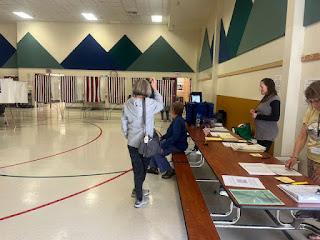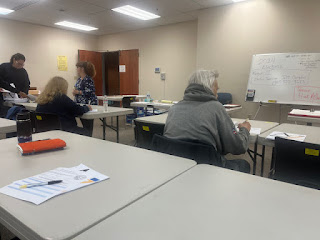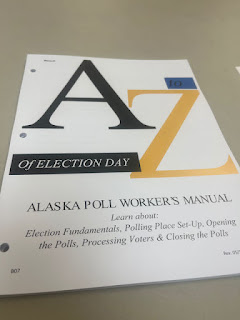When I taught English in Thailand as a Peace Corps volunteer in the late 60s, there
were 'hill tribes' up in the mountains to the west of my town. But we were also told there were communists in the mountains too, and to stay away. Hmong was not the name that Thais used. Their word, the one I knew them by then, I learned later was more of a slur than a proper name.
Despite the alleged presence of Communists in the mountains, I kept insisting I wanted to visit a 'hill tribe' village and eventually the Assistant Police chief, whose daughters I was teaching English to, arranged a trip. We were also given a big box of medicine to leave with the village. It was a very poor village and as I recall, monitored by the Thai government.
[To be clear, the pictures are all from today in Anchorage.]
 As a volunteer, I had one significant interaction with a Hmong person. I was on a bus (long distance, not within a city) and sitting next to a Hmong young man about my age - early 20s. Both of us were sitting next to a kind of person we never really ever had a chance to talk to - an American and a Hmong on a rural bus in Northern Thailand. Our common language was Thai. He wanted to know about US president Nixon and asked questions about the US and US politics. He listened to Voice of America. No Thai had ever asked me those kinds of questions, so I was surprised and interested. We had a connection and it would have been nice to be able to follow through, but we were just meeting, accidentally, in passing.
As a volunteer, I had one significant interaction with a Hmong person. I was on a bus (long distance, not within a city) and sitting next to a Hmong young man about my age - early 20s. Both of us were sitting next to a kind of person we never really ever had a chance to talk to - an American and a Hmong on a rural bus in Northern Thailand. Our common language was Thai. He wanted to know about US president Nixon and asked questions about the US and US politics. He listened to Voice of America. No Thai had ever asked me those kinds of questions, so I was surprised and interested. We had a connection and it would have been nice to be able to follow through, but we were just meeting, accidentally, in passing.
There are a number of different kinds of indigenous peoples living in the mountains of Northern Thailand, Burma, and Laos, and into China. All with different customs and languages.
Many years later when I volunteered in Chiang Mai with the American Jewish World Service, Joan and I connected with S a young Karen man. The organization where I worked asked if Joan could tutor him in English because he had been selected for a nine month long program in Japan for indigenous people from Southeast Asia, that would be conducted in English. Like the man I'd met on the bus, he was very bright and fast learner. He took us up to his village one weekend. Here's the blog post I did of that day. There are 78 posts listed under the label AJWS mostly from the two times I volunteered in Chiang Mai. [As I scrolled quickly through some of the old Thai posts, I noticed that the videos are all blank spaces. I'll have to check and see if I can track down the originals and get them reposted.]
The Hmong of Laos have a special connection to the US because they assisted the US military in fighting the Communists in Laos during the Vietnam war and so they were given special rights to immigrate to the US after the Communists took over. Many spent years in refugee camps in Thailand before gaining access to the US.
So I wanted to to to the Hmong New Year Celebration in Anchorage today. Just because. And despite it being a gray day, it was the most colorful event I remember in Anchorage. Even more colorful that Pridefest.
 |
Note: I try to blur faces of kids
|
Unfortunately I didn't think like a blogger and do some homework before I went. I didn't think like a blogger when I was there. I should have asked a lot more questions.
For instance why are they celebrating in August?
"Hmong New Years is celebrated in early December. Luang Prabang and nearby Hmong villages are great places to participate. The festival lasts for three days and according to the tradition of "Noj Peb Caug" ten different dishes of food are prepared for each day. So, this is probably the best time and place to try 30 different Asian dishes.
In-house customs involve shamans who honour spirits of wealth and healing. They release spirits to wander for awhile and then welcome them back. This is called "Hu Plig" (Spirits calling).
Outdoor New Years celebrations typically include a traditional game called pov pob (tossing a cotton ball), ox fighting, spinning-top races, and music concerts. Unique ethnic instruments like teun-flutes and khene pipes can be heard during the performances. Also, New Years is a favorable event for Hmong youth to meet a future wife or husband. In Hmong communities, it isn't allowed to marry within the clan group, so finding a partner is preferable during joint celebrations. Thus, young women and men dress in their best ethnic costumes to show off." [This comes from what appears to be a travel website, so take it with a grain of salt.]

So why are the Anchorage Hmong celebrating in August? I didn't know to ask earlier today. Maybe because they want to celebrate outdoors (they were playing what I assumed was soccer, but I didn't look too closely) and that would be less appealing in Anchorage in winter.
I had thought I should wear something Hmong, but wasn't really sure if I had anything. Somewhere there's a box with different shirts from Indigenous peoples of Thailand. I used it on a school visit once. But I couldn't find it. I'm not sure any of the items are Hmong. So I ended up taking a cloth bag that I got at the 45th Anniversary of Peace Corps Thailand that had some woven strips in them. I wasn't sure if they were Thai or possibly Hmong.
So I stopped at a tent that was selling Hmong clothing and asked a woman there what she thought.
No it didn't look Hmong. Then she proceeded to point out the various different Hmong styles. There's green Hmong, red Hmong, striped Hmong. These are al different groups of Hmong. She pointed out that much in this particular tent was machine woven instead of hand made.
Based on clothing, I would say the Hmong well outnumbered the rest of us and it appeared that most of the Hmong were splendidly dressed in traditional Hmong outfits. The woman I spoke to about the patterns on my bag said that styles were changing radically in the US and it was hard to keep up with them.






















